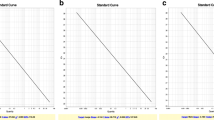Abstract
Screening for male-derived biological material from collected samples plays an important role in criminal investigations, especially those involving sexual assaults. We have developed a loop-mediated isothermal amplification (LAMP) assay targeting multi-repeat sequences of the Y chromosome for detecting male DNA. Successful amplification occurred with 0.5 ng of male DNA under isothermal conditions of 61 to 67 °C, but no amplification occurred with up to 10 ng of female DNA. Under the optimized conditions, the LAMP reaction initiated amplification within 10 min and amplified for 20 min. The LAMP reaction was sensitive at levels as low as 1-pg male DNA, and a quantitative LAMP assay could be developed because of the strong correlation between the reaction time and the amount of template DNA in the range of 10 pg to 10 ng. Furthermore, to apply the LAMP assay to on-site screening for male-derived samples, we evaluated a protocol using a simple DNA extraction method and a colorimetric intercalating dye that allows detection of the LAMP reaction by evaluating the change in color of the solution. Using this protocol, samples of male-derived blood and saliva stains were processed in approximately 30 min from DNA extraction to detection. Because our protocol does not require much hands-on time or special equipment, this LAMP assay promises to become a rapid and simple screening method for male-derived samples in forensic investigations.




Similar content being viewed by others
References
Old J, Schweers BA, Boonlayangoor PW, Fischer B, Miller KW, Reich K (2012) Developmental validation of RSID™-Semen: a lateral flow immunochromatographic strip test for the forensic detection of human semen. J Forensic Sci 57(2):489–499
Murakami H, Yamamoto Y, Yoshitome K, Ono T, Okamoto O, Shigeta Y, Doi Y, Miyaishi S, Ishizu H (2000) Forensic study of sex determination using PCR on teeth samples. Acta Med Okayama 54(1):21–32
Nicklas JA, Buel E (2006) Simultaneous determination of total human and male DNA using a duplex real-time PCR assay. J Forensic Sci 51(5):1005–1015
Kamodyová N, Durdiaková J, Celec P, Sedláčková T, Repiská G, Sviežená B, Minárik G (2013) Prevalence and persistence of male DNA identified in mixed saliva samples after intense kissing. Forensic Sci Int Genet 7(1):124–128
Nakanishi H, Shojo H, Ohmori T, Hara M, Takada A, Adachi N, Saito K (2015) A novel method for sex determination by detecting the number of X chromosomes. Int J Legal Med 129(1):23–29
Holt A, Wootton SC, Mulero JJ, Brzoska PM, Langit E, Green RL (2016) Developmental validation of the Quantifiler(®) HP and Trio Kits for human DNA quantification in forensic samples. Forensic Sci Int Genet 21:145–157
Ewing MM, Thompson JM, McLaren RS, Purpero VM, Thomas KJ, Dobrowski PA, DeGroot GA, Romsos EL, Storts DR (2016) Human DNA quantification and sample quality assessment: developmental validation of the PowerQuant(®) system. Forensic Sci Int Genet 23:166–177
Notomi T, Okayama H, Masubuchi H, Yonekawa T, Watanabe K, Amino N, Hase T (2000) Loop-mediated isothermal amplification of DNA. Nucleic Acids Res 28(12):E63
Nagamine K, Hase T, Notomi T (2002) Accelerated reaction by loop-mediated isothermal amplification using loop primers. Mol Cell Probes 16(3):223–229
Kurosaki Y, Magassouba N, Bah HA, Soropogui B, Doré A, Kourouma F, Cherif MS, Keita S, Yasuda J (2016) Deployment of a reverse transcription loop-mediated isothermal amplification test for Ebola virus surveillance in remote areas in Guinea. J Infect Dis 214(suppl 3):S229–S233
Ravan H, Amandadi M, Sanadgol N (2016) A highly specific and sensitive loop-mediated isothermal amplification method for the detection of Escherichia coli O157:H7. Microb Pathog 91:161–165
Sasaki Y, Fujimoto T, Aragane M, Yasuda I, Nagumo S (2009) Rapid and sensitive detection of Lophophora williamsii by loop-mediated isothermal amplification. Biol Pharm Bull 32(5):887–891
Kitamura M, Aragane M, Nakamura K, Watanabe K, Sasaki Y (2016) Development of loop-mediated isothermal amplification (LAMP) assay for rapid detection of Cannabis sativa. Biol Pharm Bull 39(7):1144–1149
Kitamura M, Aragane M, Nakamura K, Watanabe K, Sasaki Y (2017) Rapid identification of drug-type strains in Cannabis sativa using loop-mediated isothermal amplification assay. J Nat Med 71(1):86–95
Nogami H, Tsutsumi H, Komuro T, Mukoyama R (2008) Rapid and simple sex determination method from dental pulp by loop-mediated isothermal amplification. Forensic Sci Int Genet 2(4):349–353
Watthanapanpituck K, Kiatpathomchai W, Chu E, Panvisavas N (2014) Identification of human DNA in forensic evidence by loop-mediated isothermal amplification combined with a colorimetric gold nanoparticle hybridization probe. Int J Legal Med 128(6):923–931
Duan Y, Zhang X, Ge C, Wang Y, Cao J, Jia X, Wang J, Zhou M (2014) Development and application of loop-mediated isothermal amplification for detection of the F167Y mutation of carbendazim-resistant isolates in Fusarium graminearum. Sci Rep 4:7094
Miyamoto S, Sano S, Takahashi K, Jikihara T (2015) Method for colorimetric detection of double-stranded nucleic acid using leuco triphenylmethane dyes. Anal Biochem 473:28–33
Nakahara H, Fujii K, Mizuno N, Yoshida K, Kasai K (2007) Evaluations of DNA quantification methods for forensic biological samples. Jpn J Forensic Sci Tech 12:13–26
Kouprina N, Ebersole T, Koriabine M, Pak E, Rogozin IB, Katoh M, Oshimura M, Ogi K, Peredelchuk M, Solomon G et al (2003) Cloning of human centromeres by transformation-associated recombination in yeast and generation of functional human artificial chromosomes. Nucleic Acids Res 31(3):922–934
Aboud MJ, Gassmann M, McCord B (2015) Ultrafast STR separations on short-channel microfluidic systems for forensic screening and genotyping. J Forensic Sci 60(5):1164–1170
Author information
Authors and Affiliations
Corresponding author
Ethics declarations
This study was approved by the Human Genome/Gene Analysis Research Ethics Committee of the Japanese Association of Forensic Science and Technology. Informed consent was obtained from all individual participants included.
Competing interests
The authors declare that they have no conflict of interest.
Electronic supplementary material
ESM 1
(PDF 203 kb)
Rights and permissions
About this article
Cite this article
Kitamura, M., Kubo, S., Tanaka, J. et al. Rapid screening method for male DNA by using the loop-mediated isothermal amplification assay. Int J Legal Med 132, 975–981 (2018). https://doi.org/10.1007/s00414-017-1661-z
Received:
Accepted:
Published:
Issue Date:
DOI: https://doi.org/10.1007/s00414-017-1661-z




